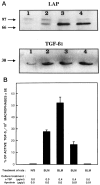Activation of rat alveolar macrophage-derived latent transforming growth factor beta-1 by plasmin requires interaction with thrombospondin-1 and its cell surface receptor, CD36
- PMID: 10487979
- PMCID: PMC1866879
- DOI: 10.1016/s0002-9440(10)65183-8
Activation of rat alveolar macrophage-derived latent transforming growth factor beta-1 by plasmin requires interaction with thrombospondin-1 and its cell surface receptor, CD36
Abstract
Transforming growth factor-beta-1 (TGF-beta1) is secreted by cells in a latent form (L-TGF-beta1) noncovalently bound to a latency-associated peptide. Activated alveolar macrophages obtained from rat lungs after bleomycin-induced pulmonary injury released increased amounts of active TGF-beta1 as well as plasmin, a protease, and thrombospondin-1 (TSP-1), a trimeric glycoprotein. Previously we had demonstrated that plasmin was critical to the activation of L-TGF- beta1. In the present study we demonstrated that TSP-1 is also important for the activation of L-TGF- beta1 because the activation can be inhibited by anti-TSP-1 monoclonal antibody. Proteins obtained from alveolar macrophage cell lysates immunoprecipitated with antibodies specific for TSP-1 were identified on immunoblots as LAP and TGF-beta1, indicating that TSP-1/L-TGF-beta1 complexes are present on alveolar macrophages. However, in the presence of plasmin both latency-associated peptide and TGF-beta1 were decreased in the same cell lysates, indicating that L-TGF-beta1 associated with TSP-1 is released by plasmin. Using immunofluorescence and antibodies to TGF-beta1 and CD36, a receptor for TSP-1, there was colocalization of TGF-beta1 with CD36. Because TSP-1 but not TGF-beta1 is a natural ligand for CD36, these findings suggest that the L-TGF-beta1 in a complex with TSP-1 localizes to the macrophage cell surface when TSP-1 interacts with its receptor, CD36. Furthermore, the association of TSP-1/L-TGF-beta1 complex with CD36 is necessary to the activation of L-TGF-beta1 because antibodies to CD36 prevent the colocalization of TGF-beta1 with CD36 as observed by immunofluorescence and inhibit activation of the L-TGF-beta1 by explanted alveolar macrophages. These findings suggest that activation of L-TGF-beta1 by plasmin occurs at the cell surface of activated alveolar macrophages and requires a TSP-1/CD36 interaction.
Figures






Similar articles
-
A TSP-1 functional fragment inhibits activation of latent transforming growth factor-beta1 derived from rat alveolar macrophage after bleomycin treatment.Exp Toxicol Pathol. 2009 Jan;61(1):67-73. doi: 10.1016/j.etp.2008.06.007. Epub 2008 Aug 21. Exp Toxicol Pathol. 2009. PMID: 18722097
-
Plasmin regulates the activation of cell-associated latent TGF-beta 1 secreted by rat alveolar macrophages after in vivo bleomycin injury.Am J Respir Cell Mol Biol. 1996 Aug;15(2):252-9. doi: 10.1165/ajrcmb.15.2.8703482. Am J Respir Cell Mol Biol. 1996. PMID: 8703482
-
A CD36 synthetic peptide inhibits bleomycin-induced pulmonary inflammation and connective tissue synthesis in the rat.Am J Respir Cell Mol Biol. 2000 Aug;23(2):204-12. doi: 10.1165/ajrcmb.23.2.4089. Am J Respir Cell Mol Biol. 2000. PMID: 10919987
-
Activation of latent TGF-beta by thrombospondin-1: mechanisms and physiology.Cytokine Growth Factor Rev. 2000 Mar-Jun;11(1-2):59-69. doi: 10.1016/s1359-6101(99)00029-5. Cytokine Growth Factor Rev. 2000. PMID: 10708953 Review.
-
CD36: a critical anti-angiogenic receptor.Front Biosci. 2003 Sep 1;8:s874-82. doi: 10.2741/1168. Front Biosci. 2003. PMID: 12957861 Review.
Cited by
-
The integrin alphavbeta3 is a receptor for the latency-associated peptides of transforming growth factors beta1 and beta3.Biochem J. 2003 Jan 15;369(Pt 2):311-8. doi: 10.1042/BJ20020809. Biochem J. 2003. PMID: 12358597 Free PMC article.
-
Thymidine Phosphorylase Promotes Abdominal Aortic Aneurysm via VSMC Modulation and Matrix Remodeling in Mice and Humans.Cardiovasc Ther. 2024 Dec 18;2024:1129181. doi: 10.1155/cdr/1129181. eCollection 2024. Cardiovasc Ther. 2024. PMID: 39742002 Free PMC article.
-
Activation of Latent TGF-β1 by Thrombospondin-1 is a Major Component of Wound Repair.Oral Biosci Med. 2005;2(2):153-161. Oral Biosci Med. 2005. PMID: 21822445 Free PMC article.
-
Inhibition of Transforming Growth Factor-β Activation Diminishes Tumor Progression and Osteolytic Bone Disease in Mouse Models of Multiple Myeloma.Am J Pathol. 2016 Mar;186(3):678-90. doi: 10.1016/j.ajpath.2015.11.003. Epub 2016 Jan 20. Am J Pathol. 2016. PMID: 26801735 Free PMC article.
-
TGF-β signaling in health, disease, and therapeutics.Signal Transduct Target Ther. 2024 Mar 22;9(1):61. doi: 10.1038/s41392-024-01764-w. Signal Transduct Target Ther. 2024. PMID: 38514615 Free PMC article. Review.
References
-
- Rappolee DA, Werb Z: Macrophage derived growth factors. Curr Topics Microbiol Immumol 1992, 181:87-140 - PubMed
-
- Stein M, Keshav A: The versatility of macrophages. Clin Exp Allergy 1992, 22:19-27 - PubMed
-
- Gleizes PE, Munger JS, Nunes I, Harpel JG, Mazzieri R, Noguera S, Rifkin DB: TGF-β latency: biological significance and mechanism of activation. Stem Cells 1997, 15:190-197 - PubMed
-
- Khalil N, Corne S, Whitman C, Yacyshyn H: Plasmin regulates the activation of cell associated latent TGF-β1 secreted by rat alveolar macrophages after in vivo bleomycin injury. Am J Resp Mol Cell Biol 1996, 15:252-259 - PubMed
Publication types
MeSH terms
Substances
Grants and funding
LinkOut - more resources
Full Text Sources
Other Literature Sources
Molecular Biology Databases
Research Materials
Miscellaneous

